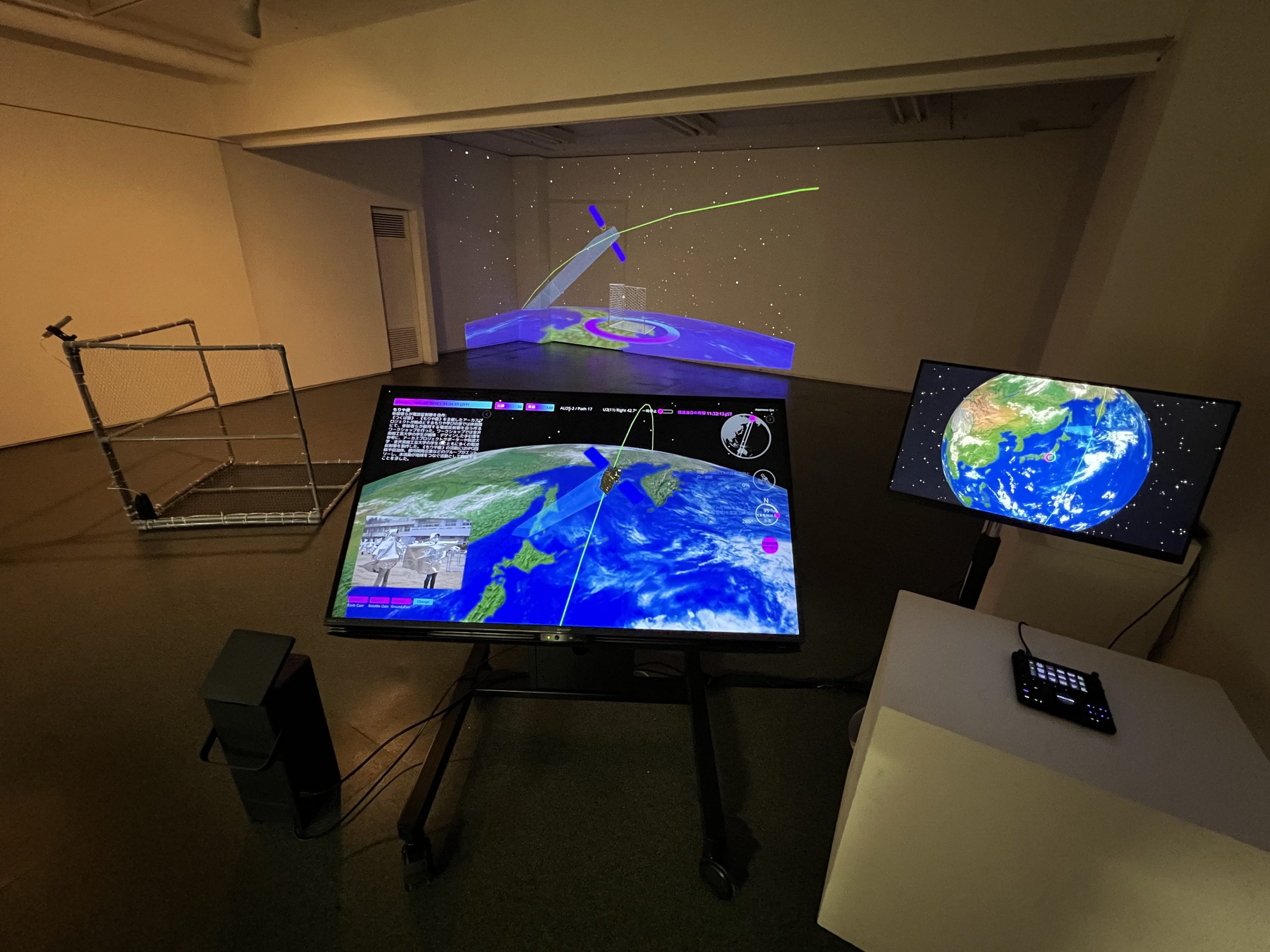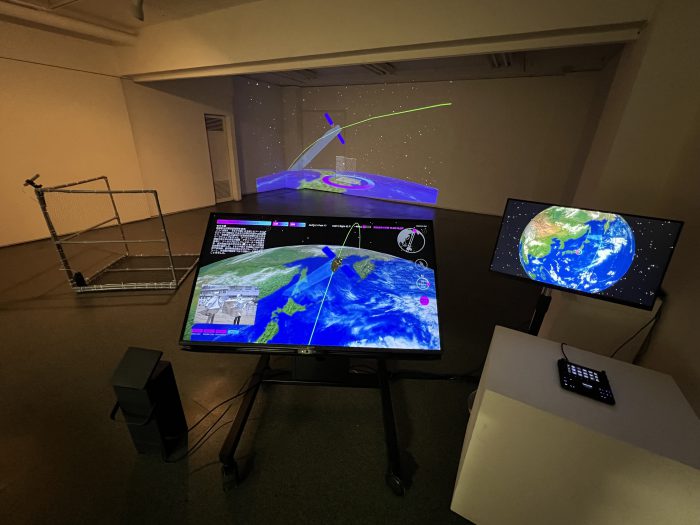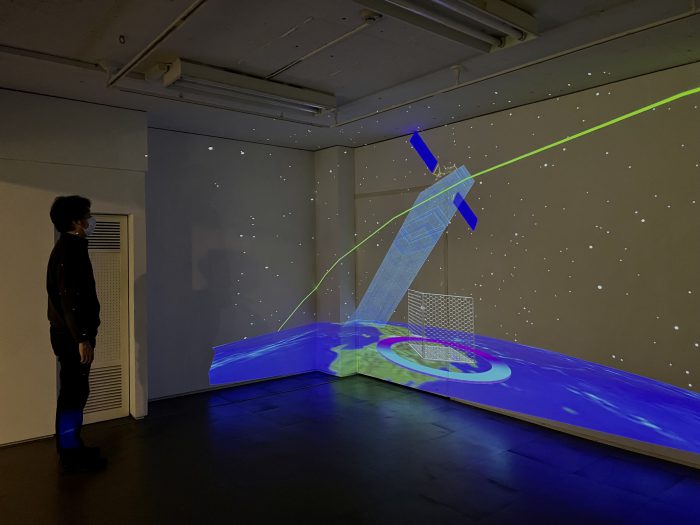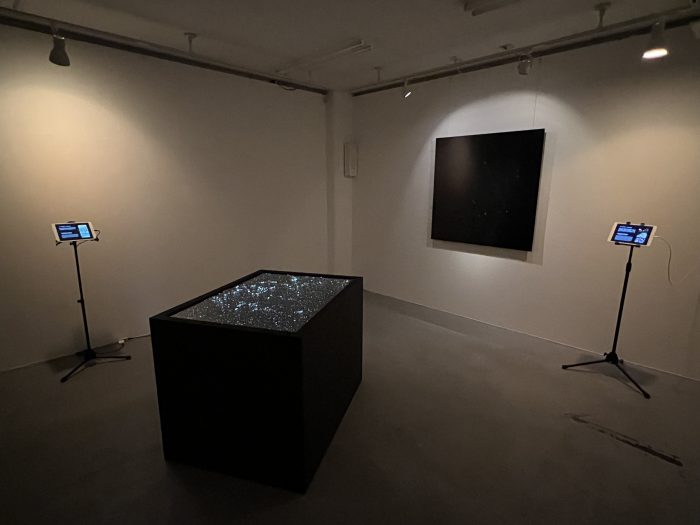2021.10.25(Mon) ー 11. 5(Fri) |close 10.31(Sun)|11:30 ー 19:00
art space kimura ASK?(Tokyo) 東京都中央区京橋3-6-5 木邑ビル2F
鈴木浩之(SUZUKI, Hiroshi)+大木真人(OHKI, Masato)
芸術とリモートセンシング
人工衛星による地球観測画像は、人の地球観を拡張する〈概観効果〉をもたらし、日々地球像を生み出す観測手段であると共に表現の源であると考えます。地球像そのものが、観測データでありながら表象文化としての芸術作品そのものである可能性もあります。活動や作品制作の背景となっている私たちの研究は、芸術分野(美術)の研究者が科学技術(工学)分野の研究者と協力し、地球外の視点である人工衛星を利用して人と社会のあり方を表現する新たな手法を考案しているところです。私たちは、2022年度に打上げが計画されている先進レーダ衛星(ALOS-4)と高度なデジタル化が進む社会環境を利用した〈新しい美学〉の実践を試み、その成果を教育プログラムとして社会に還元していきたいと考えています。従来とは異なる角度から芸術と科学の関係をとらえ直すことにより、芸術活動が科学教育の導入として機能するとともに、科学の実践が芸術の総合型教育プログラムとして機能することを明らかにしていきたいと思います。
「Constellations of the Earth / Interactive」について
「Constellations of the Earth / Interactive」(2021年、鈴木浩之+大木真人)は、アートプロジェクト「だいちの星座」の活動を追体験するインタラクティブ・アートです。2021年10月25日から11月5日にかけて「アートスペースキムラASK?」で開催した個展で紹介したこの作品は、汎用的なコンピューターやディスプレイ、プロジェクターを用いたインスタレーションと、日常的に用いられるスマートフォン向けのアプリケーションの二つのバージョンで構成されています。参加者は(作品内で)人工衛星が「だいちの星座」開催地(これまでに国内9カ所で開催)に配置された電波反射器を撮像するタイミングを待ちます。「だいちの星座」は陸域観測技術衛星「だいち2号」(ALOS-2)と手作りの電波反射器「コーナーリフレクター」(CR)を利用し、最大数十キロに及ぶ大地に新しい「星座」を描いていくアートプロジェクトです。作品では、実際に「だいちの星座」の活動を行った場所、当日の人工衛星の軌道、地上観測のエリア、描いた「星座」の星の配置を紹介しています。この作品への参加(もしくはアプリケーションの操作)によって、人工衛星を利用して自らを撮影するプロセスを擬似的に追体験しつつ、地球上の〈私〉について考える〈地球外の視点がもたらす新たな地球観(概観効果)〉の獲得が促されることを期待しました。
同個展会場の半地下階にある「アートスペースキムラASK?(P)」では、2019年に実施した「だいちの星座」の活動によって大地に描かれた「だいちの星座―かなざわ座」の作品を展示しました。「だいちの星座」は地上に配置した電波反射器を軌道上の人工衛星に観測させることで(電波反射が)衛星画像に記録される仕組みを利用しています。これまでは作品や映像を壁に配置することで展示を構成してきましたが、「だいちの星座-かなざわ座」では地上を俯瞰する人工衛星からの視点を意図し、バックライトを点灯させた作品画像を上から覗き込む展示形態を試みました。
同個展では、インタラクティブ・アート作品では実際のアートプロジェクトの記録を追体験として整理し、(アートプロジェクトあるいはツールとしての)インスタレーション、アプリケーションの可能性の拡張を試みました。また、活動によって描かれた「だいちの星座」平面作品を別フロアに展示することで、アートプロジェクト全体を紹介する構成としました。
Art and Remote Sensing
Earth observation images from artificial satellites bring about an overview effect that expands a person’s view of the Earth and are considered to be a source of expression and an observation method that creates Earth images every day. Earth images, although observational data, have the potential to be art pieces that serve as representational culture. In our research, which is the background of activities and the creation of works, researchers in the art (fine art) field collaborate with researchers in the science and technology (engineering) field to design a new method of expressing the state of people and society through the use of artificial satellites, a viewpoint that is outside planet Earth. We endeavor to practically apply new aesthetics that make use of the Advanced Land Observing Satellite-4 (ALOS-4), planned to be launched in 2022, and the social environment in which high-level digitalization is advancing. We would like to return the results of that endeavor to society as an educational program. By regrasping the relationship between art and science from an angle different than before, we seek to clarify that art activities function as an introduction to science education and that the practical application of science functions as a comprehensive type of educational program for art.
Regarding Constellations of the Earth/Interactive
Constellations of the Earth/Interactive (2021, Hiroyuki Suzuki and Masato Ohki) is an interactive art piece in which viewers can vicariously experience the activities of the art project Constellations of the Earth. This piece, introduced in a solo exhibition at art space kimura ASK? from October 25 to November 5, 2021, consists of two versions: an installation that uses an all-purpose computer or display or projector and an application for smartphones that can be used in daily life. Participants wait inside the art piece for the timing in which the artificial satellite takes an image of the radio-wave reflector placed in the area where Constellations of the Earth is being held (so far, it has been held in nine places in the country). Constellations of the Earth uses the Advanced Land Observing Satellite-2 (ALOS-2) and a handmade radio-wave reflector, the corner reflector (CR), to draw a new “constellation” on the ground that is a maximum of several tens of kilometers in size. The art piece introduces the places where Constellations of the Earth activities have been carried out, the orbit of the artificial satellite on that day, the area of land observation, and the placement of the stars of the “constellation” that was drawn. It was hoped that, through participation in this art piece (or operating the application), while vicariously experiencing in an artificial way the process of taking images using an artificial satellite, one would obtain a new view of Earth (overview effect) brought about by a viewpoint outside planet Earth that makes one think about the “me” on planet Earth.
In art space kimura ASK? (P), which is on the semi-basement level of the venue of this solo exhibition, we displayed the piece Constellations of the Earth—Kanazawa Constellation, which was drawn on the ground through Constellations of the Earth activities implemented in 2019. Constellations of the Earth uses a plan in which radio-wave reflections are recorded in satellite images by having the radio-wave reflector on the ground be observed by the artificial satellite in orbit. Thus far, exhibitions have consisted of art pieces or videos placed on walls, but in Constellations of the Earth—Kanazawa Constellation, we aimed for a viewpoint from the artificial satellite looking down on the ground, and we endeavored to have a form of exhibition where one peers in from above at the art-piece images lighted with backlights.
In the interactive art piece of this solo exhibition, we organized the actual records of an art project as a vicarious experience and endeavored to expand the potential of installations and applications as art projects or tools. Moreover, we introduced the entire art project by displaying the Constellations of the Earth two-dimensional art piece—which was drawn through the activities—on a different floor.




Comments are closed